Related Research Articles
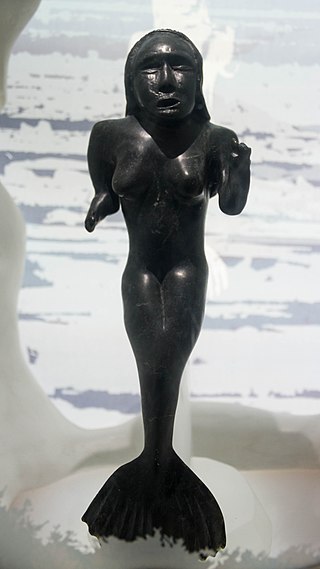
Inuit religion is the shared spiritual beliefs and practices of the Inuit, an indigenous people from Alaska, northern Canada, parts of Siberia and Greenland. Their religion shares many similarities with some Alaska Native religions. Traditional Inuit religious practices include animism and shamanism, in which spiritual healers mediate with spirits. Today many Inuit follow Christianity, but traditional Inuit spirituality continues as part of a living, oral tradition and part of contemporary Inuit society. Inuit who balance indigenous and Christian theology practice religious syncretism.

Igloolik is an Inuit hamlet in Foxe Basin, Qikiqtaaluk Region in Nunavut, northern Canada. Because its location on Igloolik Island is close to Melville Peninsula, it is often mistakenly thought to be on the peninsula. The name "Igloolik" means "there is a house here". It derives from iglu meaning house or building, and refers to the sod houses that were originally in the area, not to snow igloos. In Inuktitut the residents are called Iglulingmiut.

The Inuit angakkuq is an intellectual and spiritual figure in Inuit culture who corresponds to a medicine man. Other cultures, including Alaska Natives, have traditionally had similar spiritual mediators, although the Alaska Native religion has many forms and variants.

Atanarjuat: The Fast Runner is a 2001 Canadian epic film directed by Inuit filmmaker Zacharias Kunuk and produced by his company Isuma Igloolik Productions. It was the first feature film ever to be written, directed and acted entirely in the Inuktitut language.
Zacharias Kunuk is a Canadian Inuk producer and director most notable for his film Atanarjuat: The Fast Runner, the first Canadian dramatic feature film produced entirely in Inuktitut. He is the president and co-founder with Paul Qulitalik, Paul Apak Angilirq, and the only non-Inuit, ex-New Yorker team member, Norman Cohn, of Igloolik Isuma Productions, Canada's first independent Inuit production company. Atanarjuat: The Fast Runner (2001), the first feature film that was entirely in Inuktitut was named as the greatest Canadian film of all time by the 2015 Toronto International Film Festival poll.
John Beamish Dossetor, was a Canadian physician and bioethicist who is notable for co–coordinating the first kidney transplant in Canada and the Commonwealth.
Siqqitiq is the ritual of converting Inuit with shamanist beliefs to Christianity. This is usually accompanied by ritualistic consumption of foods held taboo by shamanist belief to underscore the fact that such taboos no longer apply.
Stephen John Hunt is a British professor of sociology at the University of the West of England. Prior to his appointment at the University of West England in 2001, Hunt had taught at the Sociology Department at the University of Reading for thirteen years, as well as in the Religious Studies Department at the University of Surrey, Roehampton.

Traditional Alaskan Native religion involves mediation between people and spirits, souls, and other immortal beings. Such beliefs and practices were once widespread among Inuit, Yupik, Aleut, and Northwest Coastal Indian cultures, but today are less common. They were already in decline among many groups when the first major ethnological research was done. For example, at the end of the 19th century, Sagdloq, the last medicine man among what were then called in English, "Polar Eskimos", died; he was believed to be able to travel to the sky and under the sea, and was also known for using ventriloquism and sleight-of-hand.
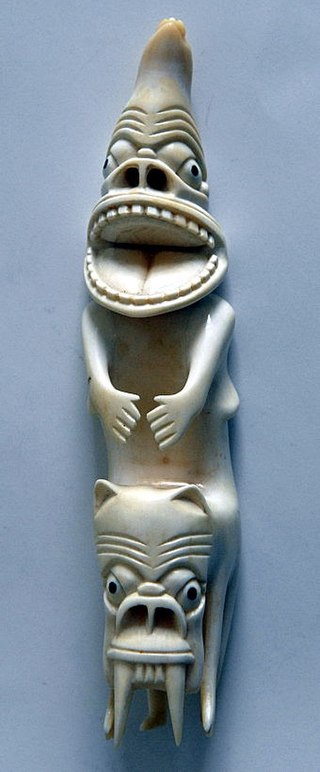
In Greenlandic Inuit religion, a tupilaq was an avenging monster fabricated by a practitioner of witchcraft or shamanism by using various objects such as animal parts and even parts taken from the corpses of children. The creature was given life by ritualistic chants. It was then placed into the sea to seek and destroy a specific enemy.
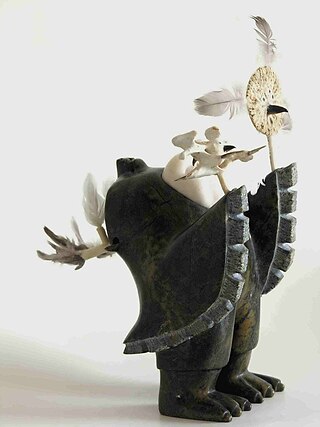
Inuit art, also known as Eskimo art, refers to artwork produced by Inuit, that is, the people of the Arctic previously known as Eskimos, a term that is now often considered offensive. Historically, their preferred medium was walrus ivory, but since the establishment of southern markets for Inuit art in 1945, prints and figurative works carved in relatively soft stone such as soapstone, serpentinite, or argillite have also become popular.

Inuit are a group of culturally similar indigenous peoples inhabiting the Arctic and subarctic regions of Greenland, Labrador, Quebec, Nunavut, the Northwest Territories, and Alaska. Inuit languages are part of the Eskimo–Aleut languages, also known as Inuit-Yupik-Unangan, and also as Eskaleut. Inuit Sign Language is a critically endangered language isolate used in Nunavut.
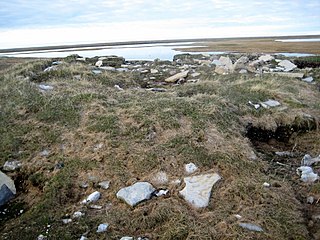
Igloolik Island is a small island in the Qikiqtaaluk Region of Nunavut, Canada. It is located in the Foxe Basin, very close to the Melville Peninsula, and it is often thought to be a part of the peninsula. It forms part of the Arctic Archipelago.
Donald Suluk was an Inuit religious figure who preached a syncretic form of Christianity in Nunavut in the 1940s.
Victor Tungilik was an Inuit religious figure who was both a Christian and a traditional angakkuq of Anglican parents. Tungilik later eschewed his angakkuq practices and moved to Naujaat.

Aua was an Inuk angakkuq known for his anthropological input to Greenland anthropologist Knud Rasmussen. As a spiritual healer practicing into the 1920s, Aua provided perspective on Inuit mythology at a time when it was being subsumed by the introduction of Christianity. Aua told the story of his cousin's mother Uvavnuk, whose song "The Great Earth" is still popular.
Artcirq is an Inuit circus performance collective based in Igloolik, Nunavut, Canada. It was co-founded in 1998 by Guillaume Saladin and several circus artists from Montreal and youth from Igloolik, with the financial support of Igloolik Isuma Productions, Canada's first Inuit independent production company and Cirque Éloize. Its activities provide Inuit youth with a vehicle for creative expression that maintains strong links to Inuit traditions and performance styles.
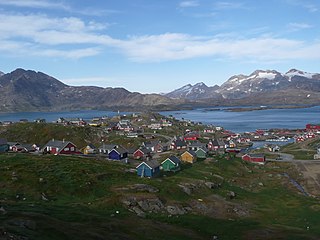
Tunumiit or Iivit are Greenlandic Inuit from Tunu or Kangia, the eastern part of Greenland. The Tunumiit live now mainly in Tasiilaq and Ittoqqortoormiit and are a part of the Arctic people known collectively as the Inuit. The singular for Tunumiit is Tunumiu.
In Inuit culture, sipiniq refers to a person who is believed to have changed their physical sex as an infant, but whose gender is typically designated as being the same as their perceived original sex. In some ways, being sipiniq can be considered a third gender. This concept is primarily attested in areas of the Canadian Arctic, such as Igloolik and Nunavik. The Netsilik Inuit used the word kipijuituq for a similar concept.

Archaeological evidence indicates that the history of Inuit clothing extends far back into prehistory, with significant evidence to indicate that the basic structure of Inuit clothing has changed little since. The clothing systems of all Arctic peoples are similar, and evidence in the form of tools and carved figurines indicates that these systems may have originated in Siberia as early as 22,000 BCE, and in northern Canada and Greenland as early as 2500 BCE. Pieces of garments found at archaeological sites, dated to approximately 1000 to 1600 CE, are very similar to garments from the 17th to mid-20th centuries, which confirms consistency in the construction of Inuit clothing over centuries.
References
- ↑ Paul Apak Angilirq, Zacharias Kunuk, Hervé Paniaq, Norman Cohn, Pauloosie Quilitalik, Bernard Saladin d'Anglure. Atanarjuat: the fast runner : inspired by a traditional Inuit legend of Igloolik. Coach House Books & Isuma Pub., 2002. ISBN 1-55245-113-5, 978-1-55245-113-7
- ↑ Aparecida Vilaça, Robin Wright. Native Christians: Modes and Effects of Christianity Among Indigenous Peoples of the Americas. Ashgate Publishing, Ltd., 2009 ISBN 0-7546-6355-8, 978-0-7546-6355-3